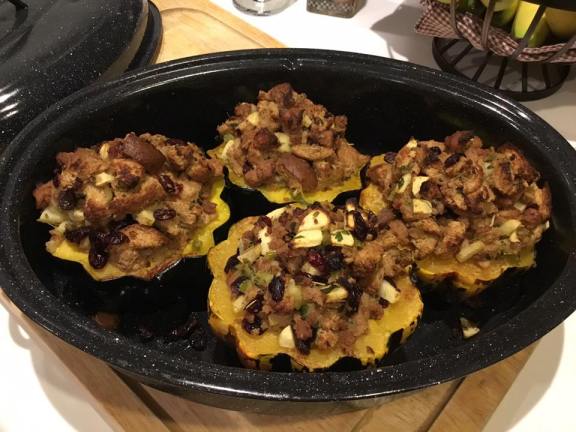
Big food events can be big fun, but they can also be a big challenge when you are trying to eat healthfully. Super Bowl Sunday is second only to Thanksgiving as the single event with the highest food consumption in America According to the American Institute on Food Distribution. This Sunday, American football fans are estimated to consume:
1.35 billion chicken wings This is enough for every man, woman and child in the US to have 4 wings each. While chicken itself is a healthy, lean source of protein, chicken wings are mostly deep fried, fatty chicken skin. Not exactly what we mean when we say “go lean with protein”. Instead of your standard chicken wings, why not try these ideas:
Grilled, boneless chicken tenderloins tossed with Frank’s Red Hot buffalo sauce, or
Buffalo Chicken Meatballs: http://shrinkingkitchen.com/buffalo-chicken-meatballs/
139 million pounds of avocados (mostly in the form of guacamole): Now, I love some good guac, and the fact that avocados are an excellent source of heart healthy monounsaturated fat sure doesn’t hurt. They are actually higher in potassium than a banana, and they are very versatile (Did you know they are a great baking substitute to swap out some of the butter in your recipes?). However, these health benefits do come with a calorie price tag. One medium avocado has 232 calories and 20g of fat, so when indulging in your favorite guacamole, go easy on the chips (or try raw veggies instead!) and watch portions. Try this great guac recipe and load it up with veggies!
http://stylingmyeveryday.com/2014/01/07/guacamole-the-incredible-avocado/
11.2 million pounds of potato chips: Who doesn’t love potato chips? But eating them with reckless abandon? Not such a good idea. Swap out your potato chips for tortilla chips which are whole grain and usually low in sodium, baked chips which are lower in calories and fat, or better yet, raw veggies which will go great with your favorite dip. Try these swap outs with this super easy dip recipe:
http://www.snack-girl.com/snack/salsa-corn-dip/
4 million pizzas: Yes, Dominos actually expects to sell 12 million slices on Sunday. Admittedly, pizza is my favorite food and I have a tough time messing with it, but here are a few tips that I really like:
Go thin: A thin crust will have less calories than a deep dish crust.
Go veggie: Load your pizza up with your favorite vegetables, which are high in nutrition and low in calories. Skip the fatty, salty meats that just add lots of calories, unhealthy fats, and sodium.
Go creative: Make a party event of making your own pizzas for the game. Try using whole grain flat breads or even cauliflower for a crust (seems to be all the recipe rage lately). Try part skim mozzarella, or use parmesan and feta cheese. The strong flavors in parm and feta go a long way, so you can use less. Try different toppings like fajita vegetables and seasonings, or make a “Hawaiian” pizza with lean ham and fresh pineapple. Here are a few great ideas:
Tomato Basil Pizza: http://www.cookinglight.com/food/quick-healthy/quick-easy-italian-recipes/white-pizza-tomato-basil-recipe?crlt_pid=camp.DGaVLBJTJi4e
Zucchini Pizza Boats: http://www.cookingclassy.com/2014/06/zucchini-pizza-boats/
Fajita Pizza: http://recipes.sparkpeople.com/recipe-detail.asp?recipe=842887
Over 50 million cases of beer: Ok, beer has some documented health benefits, but all alcohol should be consumed in moderation (moderation is defined as 1 drink per day for women, and 2 drinks per day for men). Beers with higher alcohol content are also higher in calories. Some darker beers like stouts and porters may have 180-280 calories in 12oz. So go “light” or keep drinking to a minimum. Remember, the more you drink, the more likely you are to overindulge in food as well.
~3.8 million pounds of popcorn: Popcorn is great. It is whole grain and low in calories, unless you load it up with extra stuff, like butter, cheese, chocolate, or sugar.
Try these recipes for popcorn seasoning: http://www.marthastewart.com/315089/flavored-popcorn Feel free to cut back on the salt if you need to. Make your popcorn fresh with a little of your favorite vegetable oil and just season to taste. Or, if you are in a hurry and want to buy popcorn, try Skinny Pop or Cape Cod Sea Salt seasoned bagged popcorn in the chip isle for something simple and low in calories.
As for me, I am a die hard Eagles fan, born and raised in Chester County PA, so some hometown Philly treats will be included on my Super Bowl spread….can you say cheesesteak sliders (tiny bites of this monster classic), and real Philly soft pretzels, dipped in simple mustard, of course! We’ll be keeping in mind that it’s the guys on the field getting all of the exercise, not us. So make some smart swaps or smaller portions this Sunday and share them here with us!
Oh, and Fly Eagles Fly! #GoBirds!

Cathy Shaw is a registered, licensed dietitian with the PEIA Weight Management Program










